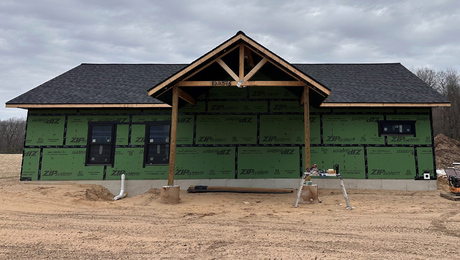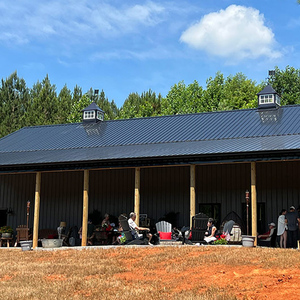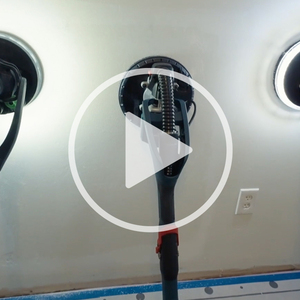I have questions regarding framing a gable roof with a large overhang at the gable ends. The overhang would project 34-1/2″ past the gable end wall. The roof is to be stick framed on site. The span from the ridge to the wall that the rafter tail will sit on is such that 2 x 8 rafters will be called for with spacing of 16″. How should I frame the look-outs that will carry the overhang and the outermost rafter? I am thinking about the rule of thumb I have always used for cantilevered structures that calls for a 2 to 1 ratio of supported structure to unsupported structure. In other words, if my lookouts project 3 feet, I need to have 6 feet in the structure, for a total size of 9 feet in length. Does this mean that I will have to notch four rafters into the roof to receive the lookouts and maybe double up the rafter that the inboard end of the lookouts butt into? And what size lookout should I use (2 x 4, 2 x 6, ect) The structure is in a 30lb/sq ft snow load zone. ? Thanks
There are a thousand hacking at the branches of evil to one who is striking at the root. — Henry David Thoreau
Edited 5/11/2005 11:45 am ET by freematt



















Replies
I would feel quite safe running 2x6 lookouts (up, not flat) out over a dropped gable wall plate, spaced 24" on center, and I would locate them so that every other one comes under roof sheathing joints. You'll use 2x6x22.5 fillers at the gable wall line.
Where you stop your last rafter set back from the gable wall is a question of sheathing layout, but I would do it so my lookouts reached at least 36" inboard. That is a cantilever scheme of about 1:1, which is OK for you and your snow loading, given 2x6 lookouts at 24 spacing.
Since the loaded cantilever is trying to rotate your lookouts up off the rafters they are bearing to inside the roof, it would be wise to clip them to the rafters with small (2x4 size will do) joist hangers, mounted topside, not bottom.
We would build a fly rafter ladder set like this on the ground, with the lookouts nailed to the fly, fillers all nailed in, and a 1x3 temp strap across the inside top, few inches back from the inside end, then hoist it up and sit it atop the gable wall, and nail off. Our ridge board would be notched and extending out past the gable wall by the appropriate amount to pick up the plumbcut top end of each fly.
Give me your rafter span, roof pitch, fly rafter size (2x6 or 2x8) eave overhang (I presume it is the same as the gable, but who knows?), and wallframe size (2x4, 2x6), and I'll draw you a sketch in 3D CAD. Right now, we're just sitting, waiting for the foundation to complete, before we begin framing, and I've got time to doodle.
"I would feel quite safe running 2x6 lookouts (up, not flat) out over a dropped gable wall plate, spaced 24" on center
Really? A 2x6 on edge notched into 2x8 rafters doesn't leave much meat on the rafters - only about 2". Guess I'd have to see your sketch to know exactly what you're saying, but it sounds a little scary to me.
I'm not talking about notching any rafters, Huck. What I said was to stop the last rafter set approaching the gable, at the point where the lookouts will begin.
The lookouts are the roof deck framing from there out.
Refer, if you have it, to the JLC Field Guide to Residential Construction, a Manual of Best Practice, page 149.
I don't know what the overall dimension of this roof plan is, but if it were my design, I might have looked at a more efficient use of roof sheathing, and made my gable overhang 32 inches, rather than the 34-1/2 inches the thread initiator said he needs.
Guess its a regional thing - here's what we call "lookouts" (also known as outriggers) in my neck of the woods.
View Image
>Gene Davis wrote: I would feel quite safe running 2x6 lookouts (up, not flat) out over a dropped gable wall plate, spaced 24" on center, and I would locate them so that every other one comes under roof sheathing joints. You'll use 2x6x22.5 fillers at the gable wall line.Gene, I follow what you are saying, but if you want to draw it I would like to see it. I don't have 3D CAD though and I'm on a Mac, so the file you generate would have to be in some pretty universal format like .gif, .jpg, .pdf or Illustrator EPS. The building is a 30'-6" x 30'-6" square (with the span being half of that) with 2x4 walls, a 4:12 pitch, 34" overhang all around and 8" fly rafter. Looking forward to seeing what you come up with. -- Matt There are a thousand hacking at the branches of evil to one who is striking at the root. -- Henry David Thoreau
Here ya go, Matt.
The sketch shows your end wall, the gable framing that plates out at bottom of 2x6 lookouts, the lookouts at 24" centers starting at your eave line, the lookouts being nailed off to your first inboard rafter at about 32" in from your gable wall line.
I didn't clip your ridge board to lessen its depth where it goes outboard, but you will want to do that. I also didn't show your barge rafter or your 2x6x22.5 fillers that will go between lookouts atop your gable plate.
Ahhh, now I see (...said the blind man to his deaf wife). Nice drawing!
Got a digital camera? Post a pic when you have the sticks up.
What size will your ridge board and fascia be?
If you used a 2x12 for the ridge and bought a 12" LVL for the fascia (assuming 2x6 rough fascia for the rest of the house) I imagine you could just cantilever out with the ridge and fascia and have no need for lookouts.
Maybe an unconventional way but I think it would be effective.
Jon Blakemore
Could I respectfully suggest you forget about cantilevered lookouts and use 4x4 knee trusses lag-bolted through to the gable framing on the outside of the sheathing? This will make your life a lot easier and also make the building look a lot nicer, IMHO....
Dinosaur
A day may come when the courage of men fails,when we forsake our friends and break all bonds of fellowship...
But it is not this day.
View Image
Egggzactly....
Dinosaur
A day may come when the courage of men fails,when we forsake our friends and break all bonds of fellowship...
But it is not this day.
That 2/1 ryule of thumb is only a simple ROT for decks. It doesn't count for structures with more over them, like a whole house, and it is overkill when the roof load is so light.
I'm with Gene, in that I would frame the gable end wall the 7" lower and extend roof framed across it. using a ridge beam is a good idea too, but using just it and a heavy facia or subfascia is borderline.
Dinos deal works too, unless it confliucts with the overall designof the house
Welcome to the
Taunton University of Knowledge FHB Campus at Breaktime.
where ...
Excellence is its own reward!
Is it too late to run the ridge long(flying out for the overhang) with the gable and next two rafters lower, allowing you to drop and a crib frame onto the lower framing members and nailed off onto the first full height rafter? This allows the crib's struts to extend out over the cantilever without notching and weakening rafters and also rest full bearing onto multiple full width framing members (gable wall and at least one rafter). Insure that the sheeting along the gable edges are staggered for full and half sheets at least, let the fill ins be in the middle of the roof run from opposing gables if need be.
"Got a digital camera? Post a pic when you have the sticks up." (I'm relaying a message from Gene Davis that I think was directed at you)
huck... i'd do the dropped gable for my cantilever..
but..
once you get past about 2'.. the structure starts to look like a 'hail mary"...
ie: no discernable means of support.. in other words.. even if you CAN cantilever it..it will still look like it shouldn't cantilever that far.. so i'd use the brackets that dinosaur drew... EVEN if they end up being simply decorative...
lots of things we build , CAN be built due to different materials and techniques.. but they can still LOOK wrong if they don't have some logic portrayed to the viewerMike Smith Rhode Island : Design / Build / Repair / Restore
Well actually, It's already up. I didn't build it, I'm just trying to see what I can do to make the best of a bad building job that someone else did. I wanted to know how it could have been done right. The knucklehead that built it has the overhang with lookouts sticking 34" beyond the gable wall and only 16" inboard of the wall! It's the 2:1 cantilever rule of thumb in reverse! I think the knee braces described earlier are a must at this point. It did survive the snow loads last winter, the first winter since it was built, but it was a pretty mild winter. One of theses years we'll get 3' or 4' of snow again. -- Matt There are a thousand hacking at the branches of evil to one who is striking at the root. -- Henry David Thoreau